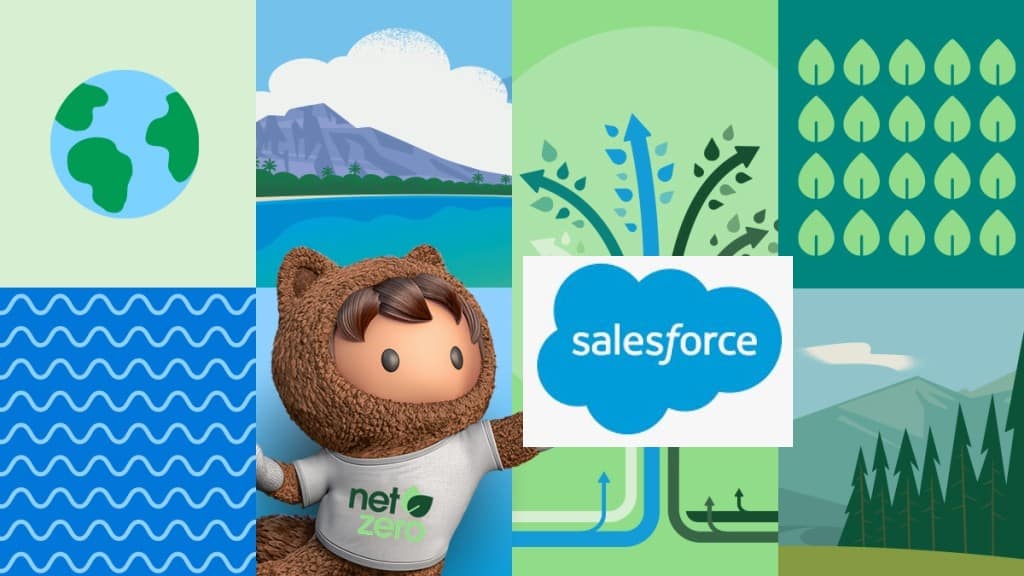The first step to achieving net zero is to reduce carbon emissions. In response to this, Salesforce will launch a first-of-its-kind carbon credit solution called the Net Zero Marketplace.
San Francisco-based Salesforce is a cloud-based tech company that provides customer relationship management (CRM) services to businesses of all sizes worldwide.
The global leader in CRM introduced its carbon credit marketplace. It’s a trusted platform that makes the process of buying carbon credits easy and transparent.
Such a solution will allow organizations to buy high-quality carbon credits from ecopreneurs to ramp up the race to net zero.
The market platform will also provide everyone with access to project pricing and 3rd-party ratings.
Many carbon credit providers join Salesforce as inaugural partners, including:
- Climate Impact Partners,
- Cloverly,
- Lune,
- Pachama,
- Respira International, and
- 3rd-party rating companies Calyx Global and Sylvera.
Boosting the Race to Net Zero
The global voluntary carbon market (VCM) is poised to grow up to $50B by 2030. This is driven by corporations’ pledges to hit their net zero targets.
Still, organizations may not know how to create a carbon credit portfolio. Some don’t even know where to begin as buying carbon credits can be complex. But they want to trust that the projects producing the credits have a positive impact.
Add to this the fact that providers of carbon credits don’t always have the tools needed to bring the credits to the market.
Enter Salesforce Net Zero Marketplace.
Salesforce carbon credit marketplace is built on the firm’s Commerce Cloud tech. It connects buyers and ecopreneurs.
- Ecopreneurs are environmentally-focused entrepreneurs who lead and drive climate action worldwide. They offer a catalog of 3rd-party rated carbon credits and a seamless ecommerce experience for buying them.
Net Zero Marketplace also features a climate action hub where anyone can learn and engage in the climate issues that matter to them.
Entities that seek to achieve long-term emission reductions can supplement their efforts with carbon credits. This is where Salesforce comes in.
Chief Impact Officer, Suzanne DiBianca, said:
“Net Zero Marketplace brings together Salesforce’s values, technology, and commitment to ecopreneurs to create a trusted market so organizations can transparently source carbon credits and accelerate climate action.”
Emission Reductions and Carbon Credits
Carbon dioxide has the same impact on the climate no matter the place and the source.
Polluters can buy carbon credits to help offset their direct emissions. Credits are from projects that avoid, reduce, or remove CO2 from the air.
Examples of carbon credit projects are forest conservation, tree planting, wind farms, solar cookstoves, or better farming methods.
While the first step to reaching net zero is to reduce emissions, that alone is not enough. Climate experts believe that this time of climate emergency calls for trying all options possible.
And carbon credits are one of them that can help incentivize more emissions reductions. They place a price on carbon, which makes an impact now while other efforts are ongoing.
Carbon projects undergo a series of verifications by global standards. If a project meets those standards, carbon credits can then be issued and sold in the market.
Salesforce carbon credit marketplace for transparency
Validating and verifying the quality of a carbon credit may take some time; the process can also be challenging.
Salesforce carbon credit marketplace tries to fix these concerns by aggregating and publishing 3rd-party ratings for projects. And that’s even possible without the need for a paywall.
The transparency of this marketplace helps organizations decide which carbon credits are most suitable for them. The partners identified earlier aid Salesforce to bring the said transparency to its platform.
For instance, Sylvera provides expert ratings to vet projects that deliver real climate benefits. And though carbon projects are very useful in fighting climate change, reliable data is vital to reveal their full potential.
With Sylvera’s ratings, Net Zero Marketplace users can discover projects that bring real climate benefits. The platform also offers carbon credit purchases to any entity, along with education and resources needed.
Any entity can access it and buy carbon credits through it. They will also be able to see project descriptions, UN Sustainable Development Goals, and 3rd-party ratings.
Buyers will also be updated on project progress, boosting reinvestment.
During the launch, Salesforce carbon credit marketplace will offer over 60 projects across Africa, Australia, Europe, Latin America, and the U.S.
Salesforce carbon credit pathways
There are two main reasons why Salesforce goes on its carbon credit journey. It sees carbon credits as a way to:
- finance nature-based solutions and new technologies needed today, and
- set an internal price on carbon to further support its emissions reduction efforts
The tech company bought its first carbon credits in 2017 as part of its climate action strategy.
Last year, it achieved net zero residual emissions across its full value chain and reached 100% renewable energy for its global operations.
Also, Salesforce launched its $100 million Climate Justice and Ecosystem Restoration Fund.
The firm will invest another $100 million in Carbon Dioxide Removal (CDR) projects by 2030. And it does this as a member of the First Movers Coalition, alongside Alphabet and Microsoft.
It will continue to reduce emissions while investing in carbon credits to offset the emissions it can’t yet reduce.
Buying carbon credit via Salesforce Net Zero Marketplace in the US starts in October this year.
The platform will expand to more markets in 2023.

